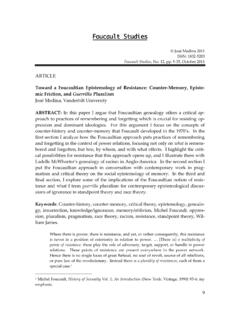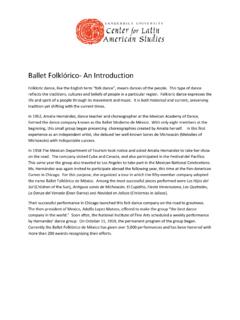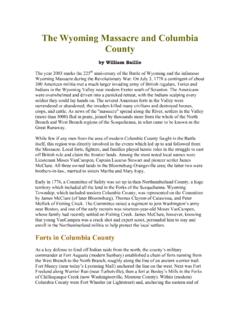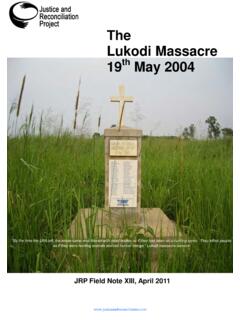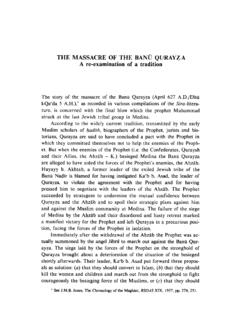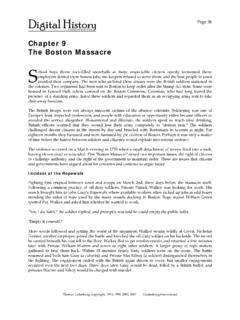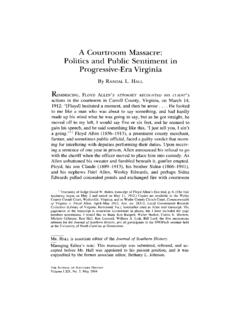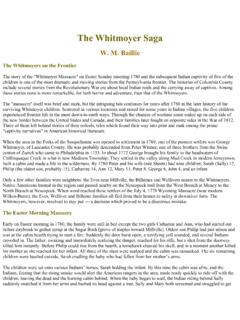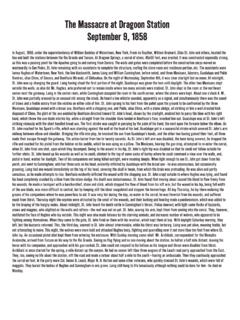Transcription of Massacre, Mardi Gras, and Torture in Early New Orleans
1 massacre , Mardi gras , and Torture in Early New OrleansAuthor(s): Sophie WhiteSource: The William and Mary Quarterly, Vol. 70, No. 3 (July 2013), pp. 497-538 Published by: Omohundro Institute of Early American History and CultureStable URL: .Accessed: 04/01/2015 21:30 Your use of the JSTOR archive indicates your acceptance of the Terms & Conditions of Use, available at ..JSTOR is a not-for-profit service that helps scholars, researchers, and students discover, use, and build upon a wide range ofcontent in a trusted digital archive. We use information technology and tools to increase productivity and facilitate new formsof scholarship. For more information about JSTOR, please contact.
2 Omohundro Institute of Early American History and Culture is collaborating with JSTOR to digitize, preserveand extend access to The William and Mary This content downloaded from on Sun, 4 Jan 2015 21:30:01 PMAll use subject to JSTOR Terms and ConditionsMassacre, Mardi gras , and Torture in Early New OrleansSophie WhiteTHE earliest known account of a Mardi gras masquerade in New Orleans was produced by Marc-Antoine Caillot, a clerk for the Company of the Indies in Louisiana. The masquerade he described took place on Fat Monday in 1730, on the outskirts of the city at Bayou Saint Jean. But the placement of the masquerade within his narrative struc-ture suggests that it should not be interpreted as a merely frivolous inter-lude.
3 Rather, Caillot s description of hedonism, feasting, and cross-gender disguises was an unexpected narrative twist given the topic he discussed immediately before and after the masquerade: his account of Mardi gras festivities was book-ended by events surrounding the 1729 uprising in which the Natchez Indians attacked French settlers at Fort Rosalie and neighboring settlements, killing, capturing, and torturing survivors. The Natchez upris-ing section of Caillot s narrative forms a coherent, self-contained segment in his manuscript. It begins with the arrival in New Orleans of ransomed colo-nists who had been stripped, their sartorial signs of Frenchness appropriated by Natchez attackers.
4 The narrative then moves to the masquerade with its description of Mardi gras disguises. It ends on the day after Easter with an account of the Torture and killing in New Orleans of a captive Natchez woman. The Tunica, an allied Indian nation, had offered the woman as a gift to Louisiana governor tienne de P rier, but he ostensibly left her to them. They proceeded to strip her to her bare body before attaching her to a square frame and ritually torturing her with White is associate professor of American Studies at the University of Notre Dame. She would like to gratefully acknowledge Guillaume Aubert, Gordon Sayre, and the anonymous readers for the William and Mary Quarterly for their robust critiques and comments.
5 She is also very grateful to Erin Greenwald and George Edward Milne for their generosity in reading a draft of the article. Emily Clark, Christian Crouch, Julia Douthwaite, Alexandre Dub , George Edward Milne, Susan North, Sue Peabody, Brett Rushforth, Christina Snyder, and C cile Vidal each helped with specific queries and, not least, with their willingness to indulge the author s obsession with this Marc-Antoine Caillot, Relation du Voyage de la Louisiane ou France fait par le Sr. Caillot en l ann e 1730, MS , Historic New Orleans Collection. Erin M. Greenwald has recently published a critical edition of Caillot s text: Greenwald, ed.
6 , A Company Man: The Remarkable French-Atlantic Voyage of a Clerk for the Company of the Indies: A Memoir by Marc-Antoine Caillot, trans. Teri F. Chalmers (New Orleans , William and Mary Quarterly, 3d ser., 70, no. 3, July 2013 DOI: content downloaded from on Sun, 4 Jan 2015 21:30:01 PMAll use subject to JSTOR Terms and Conditions498william and mary quarterly498 Caillot did not reference any parallels between Tunica Torture rituals and their precedents in the court-sanctioned Torture of criminals in French judicial investigations or the burning at the stake of heretics. Instead, what was most galling for the author was the fact that the French (namely, some of the escapees from the uprising) had joined in, and even outdone, the Tunica methods of Torture by fire.)
7 Caillot established this point through the comingling of descriptions of Torture with food preparation metaphors, culminating in one transgressive and gendered act of feasting on the female victim s naked flesh. It was the participation of French men and women in what he depicted as Indian-style Torture that perturbed him, for it raised questions about the risk of ostensibly civilized French colonists becoming Natchez uprising would permanently enter the political and liter-ary imagination in France. But this event was especially traumatic for the French in Louisiana, and colonists as well as officials responded with writ-ten accounts of the events leading up to the attack, the attack itself, and its immediate aftermath.
8 One leitmotif of these accounts, and one therefore that demands our attention, was their references to transformations, spe-cifically sartorial ones. Whether describing massacre , captivity, plunder, or Torture , these accounts alternated the passivity of being stripped with the agency of getting re-dressed (or dressed up). The ransomed captives of 1729 focused on being stripped by Natchez Indians, who in turn eagerly dressed in the captives clothes. On arrival back in New Orleans , the captives will-ingly accepted the new French clothing provided to them by company officials, while a female Natchez captive was ritually stripped prior to being scalped and put to death.
9 Interwoven with his descriptions of captives and captors stripped, dressed, and tortured, Caillot introduced a narra-tive device centered on masquerade disguises. These sartorial elements all evoked the theme of metamorphosis: the loss and transfer of power when stripped, tortured, and killed, or the renewal of power when colonists bod-ies that had been temporarily divested of their conventional sartorial mark-ers recovered their Frenchness through the material act of ). See especially Greenwald s excellent introduction, which reveals her research to uncover the authorship and history of the manuscript, as well as Caillot s biography before and after his sojourn in Louisiana; ibid.
10 , xiii xvii, xxxiv xxxviii, xvii xxii, xxxii xxxiii. The segment on the Natchez uprising, Mardi gras masquerade, and Torture is found on 143 71 of Caillot s original manuscript; it was followed on pages 172 81 by an account of the ensuing, and ultimately successful, military campaigns against the Natchez. Unless otherwise noted, all translations in this article, whether of the Caillot manuscript or of other sources, are Sauvage, the French term for Indian, will be used in preference to the English sav-age to retain the original French definition of the word as wild or Literary engagement with the Natchez Indians and the uprising would resonate in the French literary imagination into the nineteenth century, from Fran ois-Auguste-This content downloaded from on Sun, 4 Jan 2015 21:30.


